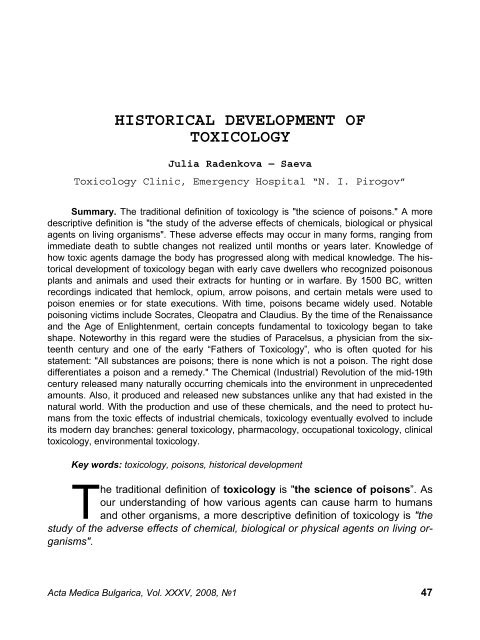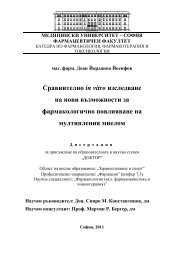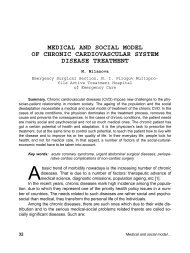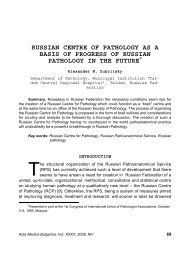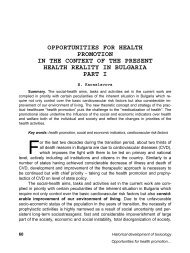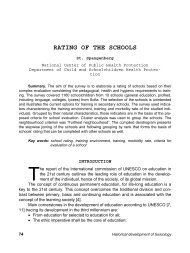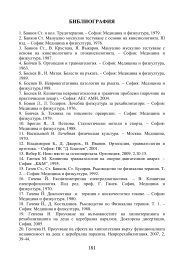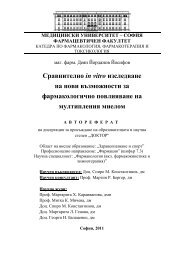HISTORICAL DEVELOPMENT OF TOXICOLOGY
HISTORICAL DEVELOPMENT OF TOXICOLOGY
HISTORICAL DEVELOPMENT OF TOXICOLOGY
You also want an ePaper? Increase the reach of your titles
YUMPU automatically turns print PDFs into web optimized ePapers that Google loves.
<strong>HISTORICAL</strong> <strong>DEVELOPMENT</strong> <strong>OF</strong><br />
<strong>TOXICOLOGY</strong><br />
Julia Radenkova – Saeva<br />
Toxicology Clinic, Emergency Hospital “N. I. Pirogov”<br />
Summary. The traditional definition of toxicology is "the science of poisons." A more<br />
descriptive definition is "the study of the adverse effects of chemicals, biological or physical<br />
agents on living organisms". These adverse effects may occur in many forms, ranging from<br />
immediate death to subtle changes not realized until months or years later. Knowledge of<br />
how toxic agents damage the body has progressed along with medical knowledge. The historical<br />
development of toxicology began with early cave dwellers who recognized poisonous<br />
plants and animals and used their extracts for hunting or in warfare. By 1500 BC, written<br />
recordings indicated that hemlock, opium, arrow poisons, and certain metals were used to<br />
poison enemies or for state executions. With time, poisons became widely used. Notable<br />
poisoning victims include Socrates, Cleopatra and Claudius. By the time of the Renaissance<br />
and the Age of Enlightenment, certain concepts fundamental to toxicology began to take<br />
shape. Noteworthy in this regard were the studies of Paracelsus, a physician from the sixteenth<br />
century and one of the early “Fathers of Toxicology”, who is often quoted for his<br />
statement: "All substances are poisons; there is none which is not a poison. The right dose<br />
differentiates a poison and a remedy." The Chemical (Industrial) Revolution of the mid-19th<br />
century released many naturally occurring chemicals into the environment in unprecedented<br />
amounts. Also, it produced and released new substances unlike any that had existed in the<br />
natural world. With the production and use of these chemicals, and the need to protect humans<br />
from the toxic effects of industrial chemicals, toxicology eventually evolved to include<br />
its modern day branches: general toxicology, pharmacology, occupational toxicology, clinical<br />
toxicology, environmental toxicology.<br />
Key words: toxicology, poisons, historical development<br />
T<br />
he traditional definition of toxicology is "the science of poisons”. As<br />
our understanding of how various agents can cause harm to humans<br />
and other organisms, a more descriptive definition of toxicology is "the<br />
study of the adverse effects of chemical, biological or physical agents on living organisms".<br />
Acta Medica Bulgarica, Vol. XXXV, 2008, №1 47
The historical development of toxicology began with early cave dwellers who<br />
recognized poisonous plants and animals and used their extracts for hunting or in<br />
warfare.<br />
Antiquity (3000 BCE – 90 CE)<br />
Earliest man was well aware of the toxic effects of animal venoms and poisonous<br />
plants. The Ebers papyrus, perhaps our earliest medical record (circa<br />
1500 BC), contains information extending back many centuries. Of the more than<br />
800 recipes given, many contain recognized poisons. For example, one finds hemlock,<br />
which later became the state poison of the Greeks; aconite, an arrow poison<br />
of the ancient Chinese; opium, used as both poison and antidote; and such metals<br />
as lead, copper, and antimony.<br />
Sumerian texts (1400 BC) refer to a female deitty – Gula. This mythological<br />
figure was associated with charms, spells and poisons. Also called the "Goddess<br />
of Healing" or "the great physician".<br />
In the mythology and literature of classic Greece, one finds many references<br />
to poisons and their use, and it was during this period that the first professional<br />
treatment of the subject began to appear.<br />
Hippocrates, while introducing rational medicine about 400 BC, added a<br />
number of poisons. He further wrote instructions that might be considered primitive<br />
principles of toxicology, in the form of attempts to control absorption of the toxic<br />
materials in therapy and overdosage.<br />
Homer (about 850 BCE) wrote of the use of arrows poisoned with venom in<br />
the epic tale of The Odyssey and The Iliad. The Greek toxikon is arrow poison.<br />
The Romans too made considerable use, often political of poisons. Many legends<br />
and myths have grown out of the skill of poisoners and the occupational hazards of<br />
political life. One such legend tells of the King Mithridates VI of Pontus. Mithridates<br />
VI (131-63 BC) was from a young age period of being poisoned. He went<br />
beyond the art of poisons to systematically study how to prevent and counteract<br />
poisons. He used both himself and prisoners as “guinea pigs” to test his poisons<br />
and antidotes. He consumed mixtures of poisons to protect himself, which is the<br />
origin of the term “mithridatic”.<br />
Cleopatra's (69-30 BC) knowledge of natural, primitive toxicology permitted<br />
her the more genteel method of falling on her asp instead. Queen of Egypt experimented<br />
with strychnine and other poisons on prisoners and poor. Committed suicide<br />
with Egyptian Asp (Egyptian cobra sometimes used in executions).<br />
Aulus Cornelius Celsus (25 BC – 50 AD) promoted cleanliness and recommended<br />
the washing of wounds with an antiseptic such as vinegar. He published<br />
De Medicina which contained information on diet, pharmacy, surgery and preparation<br />
of medical opiods.<br />
48<br />
Historical development of toxicology
Dioscorides, a Greek physician in the court of Emperor Nero, made the first<br />
attempt at a classification of poisons, which was accompanied by descriptions and<br />
drawings. The separation into plant, animal, and mineral poisons he used not only<br />
remained a standard for 16 centuries, but is still a convenient classification today.<br />
Dioscorides also dabbled in therapy, recognizing the use of emetics in poisoning<br />
and the use of caustic agents or cupping glasses in snakebite. Poisoning with plant<br />
and animal toxins was quite common.<br />
Perhaps the best-known recipient of a poison used as a state method of execution<br />
was Socrates (470-399 в.с), although he was in distinguished company.<br />
The active chemical used was the alkaloid coniine which, when ingested causes<br />
paralysis, convulsions and potentially death.<br />
Rome, poisoning seemed to take on epidemic characteristics. Although most<br />
poisons used during the period were of vegetable origin, the sulfide of arsenic and<br />
arsenous acid were known to be used.<br />
It has been postulated that arsenic was the poison with which Agrippina<br />
killed Claudius to make Nero the emperor of Rome. This postulate is supported by<br />
the later use of the same material by Nero in poisoning Britannicus, Claudius's<br />
natural son. The deed was performed under the direction of Locusta, a professional<br />
poisoner attached to the family.<br />
Mount Vesuvius erupted August 24th 79 CE. City of Pompeii and Herculaneum<br />
destroyed and buried by ash. Pliny the Elder suffocated by volcanic gases.<br />
In less organized but more colorful ways, the citizens of Italy in the Middle<br />
Ages also practiced the art of poisoning. A famous figure of the time was a lady<br />
named Toffana, who peddled specially prepared arsenic-containing cosmetics<br />
(Agua Toffana).<br />
Greek Fire (napalm) was used heavily by the Byzantines in the middle ages in<br />
both battles on land and at sea. The weapon was most notably used against Constatinople<br />
by Caloph Suleiman.<br />
A famous Jewish Philosopher, Moses Maimonides (1135-1204) was born in<br />
Spain and he was educated at the University of Fes. Maimonides wrote the famous<br />
Treatise on Poisons and Their Antidotes, a first-aid guide to the treatment of accidental<br />
or intentional poisonings and insect, snake, or mad dog bites.<br />
Generally in charge of political stability within the republic of Venice, the<br />
council of ten was a powerful and secretive political group between 1310 and<br />
1797. This group also used methods such as poisoning to kill off threatening controversial<br />
figures.<br />
Among the prominent families engaged in poisoning, the Borgias are the<br />
most notorious. True, however, that Alexander VI, his son Cesare, and Lucretia<br />
Acta Medica Bulgarica, Vol. XXXV, 2008, №1 49
were quite active. Well known Italian assasins during the 15th and 16th century,<br />
the Borgia's utilized arsenic to poison for both political and monetary gain.<br />
Pope Clement VII (1478-1534) died (possibly murdered) after eating amanita<br />
phalloides (death-cap) mushroom.<br />
A significant figure in the history of science and medicine in the late Middle<br />
Ages was the renaissance man, Philippus Aureolus Theophrastus Bombastus<br />
von Hohenheim – Paracelsus. Famous for his words "the dose makes the<br />
poison", Paracelsus was born in Switzerland and studied at the University of<br />
Vienna and was one of the first to apply chemicals and minerals into medicines.<br />
“All substances are poisons; there is none which is not a poison. The right dose<br />
differentiates a poison from a remedy.” Between the time of Aristotle and the<br />
age of Paracelsus, there was little substantial change in the biomedical sciences.<br />
In the sixteenth century, the revolt against the authority of the Church<br />
was accompanied by a parallel attack on the godlike authority exercised by the<br />
followers of Hippocrates and Galen. Paracelsus formulated many thenrevolutionary<br />
views that remain an integral part of the present structure of toxicology.<br />
He promoted a focus on the "toxicon", the toxic agent, as a chemical<br />
entity. Further, in a very real sense, this was the first sound articulation of the<br />
dose-response relation, which is a bulwark of toxicology.<br />
An avid political advocate later on in her life as Queen of France, Catherine<br />
Medici often used poisoning as a political tool during her reign. To develop more<br />
advanced poisons, Catherine also experimented with poisons on the sick and poor.<br />
Catherine tested toxic concoctions, carefully noting the rapidity of the toxic response<br />
(onset of action), the effectiveness of the compound (potency), the degree<br />
of response of the parts of the body (specificity, site of action), and the complaints<br />
of the victim (clinical signs and symptoms). Clearly, Catherine must be given credit<br />
as perhaps the earliest untrained experimental toxicologist.<br />
Using arsenic to poison their victims, Roman women, Hieronyma Spara<br />
(~1659) formed Spara's secret organization in Rome and helped women plot to kill<br />
their wealthy husbands to inherit the money and become wealthy widows.<br />
Catherine Monvoisin (La Voisin) (1640-1680) accused sorcerer and convicted<br />
poisoner in France. She was burned at the stake February 22, 1860.<br />
Guilia Tophania (1635-1719) also was a supplier of poison to wives who<br />
wanted to be widows. She was executed later on by strangulation and to stop the<br />
murder incidents from continuing, King Louis XIV passed a decree forbidding the<br />
sale of poisons from apothecaries to unknown persons.<br />
Often cited as the founder of modern toxicology is Mattieu Joseph Bonaventura<br />
Orfila (1787-1853), a Spanish physician who held a position of respect as at-<br />
50<br />
Historical development of toxicology
tending physician to Louis XVIII of France and occupied a chair at the University of<br />
Paris. Orfila was the first to attempt a systematic correlation between the chemical<br />
and biologic information of the thenknown poisons. Much of his contribution was<br />
based on personal observation of the effect of poisons in several thousand dogs.<br />
Orfila also turned attention to problems combining chemistry and jurisprudence.<br />
The introduction of this approach survives in modern toxicology as one specialty<br />
area, that of forensic toxicology.<br />
The Chemical (Industrial) Revolution of the mid-19th century released many<br />
naturally occurring chemicals into the environment in unprecedented amounts.<br />
Also, it produced and released new substances unlike any that had existed in the<br />
natural world.<br />
With the production and use of these chemicals, and the need to protect humans<br />
from the toxic effects of industrial chemicals, toxicology eventually evolved to<br />
include its modern day branches: general toxicology, pharmacology, occupational<br />
toxicology, clinical toxicology, environmental toxicology.<br />
Scientists eventually recognized the linkages among illnesses and exposures<br />
to these compounds. Some of the first reports of occupational illness, or diseases<br />
caused by activities related to specific occupations, can be found in literature from<br />
the mid - to late-1500’s.<br />
Early occupational observations include the ill effects from lead mining and<br />
madness caused by mercury exposure (for example, the saying “mad as a hatter”<br />
was attributed to the common use of mercury in the hat felting process).<br />
Later, in the 1700’s, Bernadino Ramazzini is credited with bringing to light<br />
diseases of tradesmen, including silicosis in stone workers and lead poisoning.<br />
In the late 1700’s, Sir Percival Potts made one of the more famous observations<br />
in toxicology, linking an occupational exposure (in this case soot in chimney<br />
sweeps) to cancer of the scrotum.<br />
Towards the midlate 20-th century, environmental toxicology was developed<br />
to specifically address the effects on both humans and wildlife of chemicals<br />
released into the environment. A notable differences among the branches of<br />
toxicology is that pharmacology, pesticides and even occupational toxicology primarily<br />
have focused on the effects of relatively high concentrations of single chemicals.<br />
This compares to the relatively low concentrations of several different chemicals<br />
or chemical mixtures that are relevant to environmental toxicology.<br />
During the late 1940’s and the 1950’s, attention was focused on air pollutants<br />
and the occurrence of generalized health problems in polluted areas, as well as a<br />
few very serious incidents which led to numerous fatalities. The 1960’s were<br />
marked by attention to other products, such as DDT, and to the pollution of water<br />
from waste streams emitted by industry. In the 1970’s and 1980’s, the focus has<br />
shifted to a variety of other chemicals, such as PBB’s and dioxins, and to general<br />
Acta Medica Bulgarica, Vol. XXXV, 2008, №1 51
problem of contamination of air, water, and soil by improperly contained wastes,<br />
especially in landfills.<br />
Toxicology has now become much more than the use of poisons for nefareous<br />
purposes and production of antidotes to them. The enormous and increasing<br />
number of manmade chemicals in the environment to which we may potentially be<br />
exposed has thrust toxicology into the limelight. It has also created the need for the<br />
organized study of toxic substances by the industries manufacturing them and for<br />
legislation to control them. This has in turn resulted in establishment of government<br />
regulatory agencies to implement the resulting legislation.<br />
52<br />
REFERENCES<br />
1. C a s a r e t t and Doull’s Toxicology. The Bacic Science of Poisons. N. Y., Macmillan<br />
Publishing Co, Inc, 1980.<br />
2. K a m r i n, M. A. Toxicology. Albany, USA, Lewis publishers, 1988.<br />
3. T h i e n e s, C. H. et T. J. Haley. Clinical Toxicology. Philadelphia, Lea et Fabiger, 1972.<br />
4. T i m b r e l l, J. A. Introduction to toxicology. N. Y., Taylor et Fransis, 1989.<br />
Address for correspondence:<br />
Julia Radenkova – Saeva, MD, PhD<br />
Toxicology Clinic<br />
Emergency Hospital “N.I.Pirogov”, Sofia<br />
21 Totleben blvd.<br />
1606 Sofia<br />
е-mail: jrsaeva2@yahoo.co.uk<br />
Historical development of toxicology


